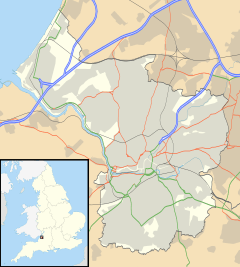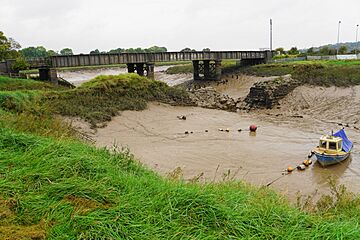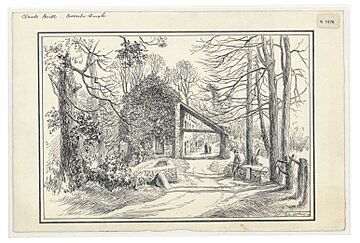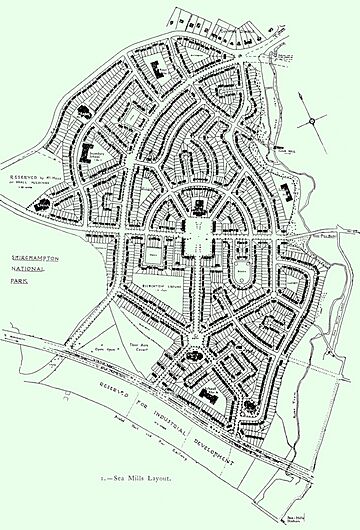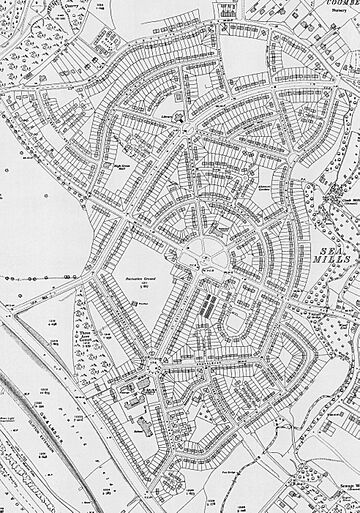Sea Mills, Bristol facts for kids
Quick facts for kids Sea Mills |
|
|---|---|
| OS grid reference | ST551207 |
| Unitary authority | |
| Ceremonial county | |
| Region | |
| Country | England |
| Sovereign state | United Kingdom |
| Post town | BRISTOL |
| Postcode district | BS9 |
| Dialling code | 0117 |
| Police | Avon and Somerset |
| Fire | Avon |
| Ambulance | Great Western |
| EU Parliament | South West England |
| UK Parliament |
|
Sea Mills is a part of Bristol, England. It's about 3.5 miles (5.6 km) north-west of the city centre. You can find it between the older villages of Shirehampton, Westbury-on-Trym, and Stoke Bishop. It's right where the River Trym meets the bigger River Avon.
Sea Mills used to be in the Kingsweston council ward. After some changes in 2015, most of Sea Mills is now in the Stoke Bishop ward. A smaller part is in the Avonmouth and Lawrence Weston ward.
Contents
Discovering Sea Mills: A Journey Through Time
Where Did the Name "Sea Mills" Come From?
The name Sea Mills comes from an old watermill. This mill was located near the River Trym where the tide reached. Records show it was called Semmille in 1411 and Cemille in 1484. The name likely meant it could grind one "seam" (a packhorse-load) of grain. Later, people thought it meant "mill by the sea."
The name then spread to a nearby farm, Seamill Farm. It also applied to one of England's first wet docks, called Seamill Dock. A wet dock has gates that hold water at high tide, keeping ships floating.
The Old Dock and Its Challenges
This dock was built on 12 acres (5 hectares) of land in 1712. It was meant to be a place where ships could be repaired and stored. This was important because the docks further up the Avon in Bristol were very busy.
However, getting goods to and from Bristol by land was difficult. This problem caused the dock and its warehouses to be given up in the 1760s. Today, you can still see the ruined dock walls. Until recently, small boats were kept in the harbour, even though it was very silty.
Other Mills in the Area
The original Sea Mill stopped working before 1800. But two other watermills further up the River Trym were used until the 1900s. These were Clack Mill and Coombe Mill. Both of these mills were taken down by the 1950s. Their water channels (mill leats) and a mill pond were also removed.
By 1830, the name Sea Mills was used for the farm, the dock area, and an 18th-century tavern. This tavern was later turned into a farmhouse called The Hermitage. It was demolished in the 1930s when new roads were built.
Sea Mills Railway Station
In 1865, the Bristol Port and Pier Railway opened. It ran along the Avon from Hotwells to a new pier at Avonmouth. The station built near the River Trym was named Sea Mills. It served the wealthy areas of Stoke Bishop and Sneyd Park.
Passenger trains to Bristol's main station, Temple Meads, started in 1886. This happened after a long tunnel was built under the Downs. Trains still run today. The original railway line between Hotwells and Sneyd Park Junction closed in 1922 to make way for the Portway road.
Abona: A Roman Port?
People long believed there was an ancient Roman port at the mouth of the River Trym. Many Roman items were found when Seamill Dock was built. All these finds were on the south side of the river.
In the 1820s, it was thought that this was the site of Abona. This was a Roman port that connected places like Silchester and Bath with Venta Silurum (Caerwent) in Wales. It was listed on an old Roman map from the 3rd century. At that time, there were no other ports or towns in the Bristol area. Digs since then have found signs of Roman streets, buildings, and cemeteries.
Sea Mills Garden Suburb: Homes for Heroes
Before the 1900s, Sea Mills was all countryside. After the First World War, the British government started a plan to build "homes fit for heroes." This was to provide good housing for soldiers returning from the war.
In April 1919, Bristol Corporation (the local council) bought two farms. They planned to build a "garden suburb" there. This meant building homes with lots of green space, following new housing standards. The suburb was named after Sea Mills Farm. Most of it was built on what used to be Clack Mill Farm.
Planning and Development
Dr Christopher Addison, the minister in charge of this housing plan, visited Sea Mills on June 4, 1919. He helped start the building work, and a special tree was planted. This tree, called Addison's Oak, still stands in Sea Mills Square. It was even a runner-up in the 2019 Woodland Trust Tree of the Year competition!
The initial plan for Sea Mills Square was changed. It became less formal, with more open spaces and fewer sharp corners. This was to make it fit the land better and create a nicer feel.
The person who sold the farms, Philip Napier Miles of Kings Weston House, was very interested in the design. He made sure the houses were not too close together. He also gave land for parks and a golf course. He even donated land for the Portway road.
Housing Features
Between 1920 and 1931, 1279 houses were built. Most were council houses (1030). All the homes had a bathroom, an inside toilet, a kitchen, and a garden big enough to grow food. Most had three bedrooms, but some had four for larger families. Sea Mills was a very important housing project for Bristol. The rents were quite high, and strict rules were kept for how the homes and gardens looked.
Celebrating 100 Years of Homes
In 2019, the Sea Mills 100 project celebrated 100 years of these "homes fit for heroes." Events included a birthday party for Addison's Oak and a heritage trail. A lasting part of the project is a mini-museum inside a K6 phone box on Sea Mills Square. Local volunteers helped fix up the phone box. The project also published a book called How Lucky I Was, with stories from people who grew up in the area.
Important Buildings in Sea Mills
Churches and Schools
Of the many churches planned, only two were built. The Methodist church on Sea Mills Square opened in 1931. St Edyth’s (Church of England) was opened in 1928. These two churches are at opposite ends of the garden suburb's main road, St. Edyth’s Road. More recently, a former Methodist church hall has become a church for another group.
Sea Mills Junior School was the only school built before World War II. It opened in 1928. A second building for younger children opened in 1931. The younger children's school later moved to a new building, but it has now moved back to the Junior School site.
Library and Community Hubs
A public library, which wasn't in the first plan, opened in 1934. It's in a noticeable spot on Sylvan Way. A community centre for Sea Mills was built behind it in the late 1950s.
Also from the 1950s is a building that used to be public toilets on Sea Mills Square. It was changed into a popular place called the Café on the Square. Princess Anne officially opened it on May 24, 2012.
Sea Mills: A Special Conservation Area
In 1981, Sea Mills became one of the first housing estates in the country to be named a conservation area. This means it's a special place that is protected because of its history and unique design as a "garden suburb." This area was chosen because of its early date and how well it kept its original look.
The conservation area was made bigger in 2008. It now includes more of the garden suburb and nearby areas that help keep its green, open feel. This includes Haig Close, which has old almshouses for disabled ex-servicemen. It also includes a large former pub, now a nursery, and some shops.
Sports and Fun in Sea Mills
Sea Mills has its own football team, Sea Mills Park FC, started in 1925. They play in the Bristol Premier Combination league. Their home games are now played at Kingsweston Sports & Social. There are also tennis courts near Sea Mills Square, which were part of the original plan for the suburb.
The Portway Rugby Development Centre opened in 2006. It has modern pitches for rugby and football, plus training areas and meeting rooms. Many local rugby and football clubs use these facilities.
Getting Around Sea Mills
Bus Services
You can find frequent bus services on Shirehampton Road, Westbury Lane, Sylvan Way, and the Portway. These buses connect Sea Mills to many parts of Bristol, including the city centre, Avonmouth, Westbury-on-Trym, Southmead, and Cribbs Causeway.
Train Services
Sea Mills station is on Bristol’s local railway line. Trains run every half-hour to Temple Meads and Avonmouth most days. On Sundays, they run hourly. There have been no staff at the station since 1967, so you buy tickets on the train. In 2021, a colourful mural showing local plants and animals was created at the station.
The Portway Road
The Portway (A4) is a main road that runs along the edge of Sea Mills. It connects central Bristol with its port at Avonmouth. When it opened in 1926, the Portway was the most expensive road in the UK. Both the Portway and the railway line have bridges over the River Trym at Sea Mills.
Famous People from Sea Mills
- Robin Cousins, a former Olympic champion in figure skating
- Roger Hallett, an artist
- The Cougars, a music band
- Derek Robinson, a novelist
- Simon King, a broadcaster


